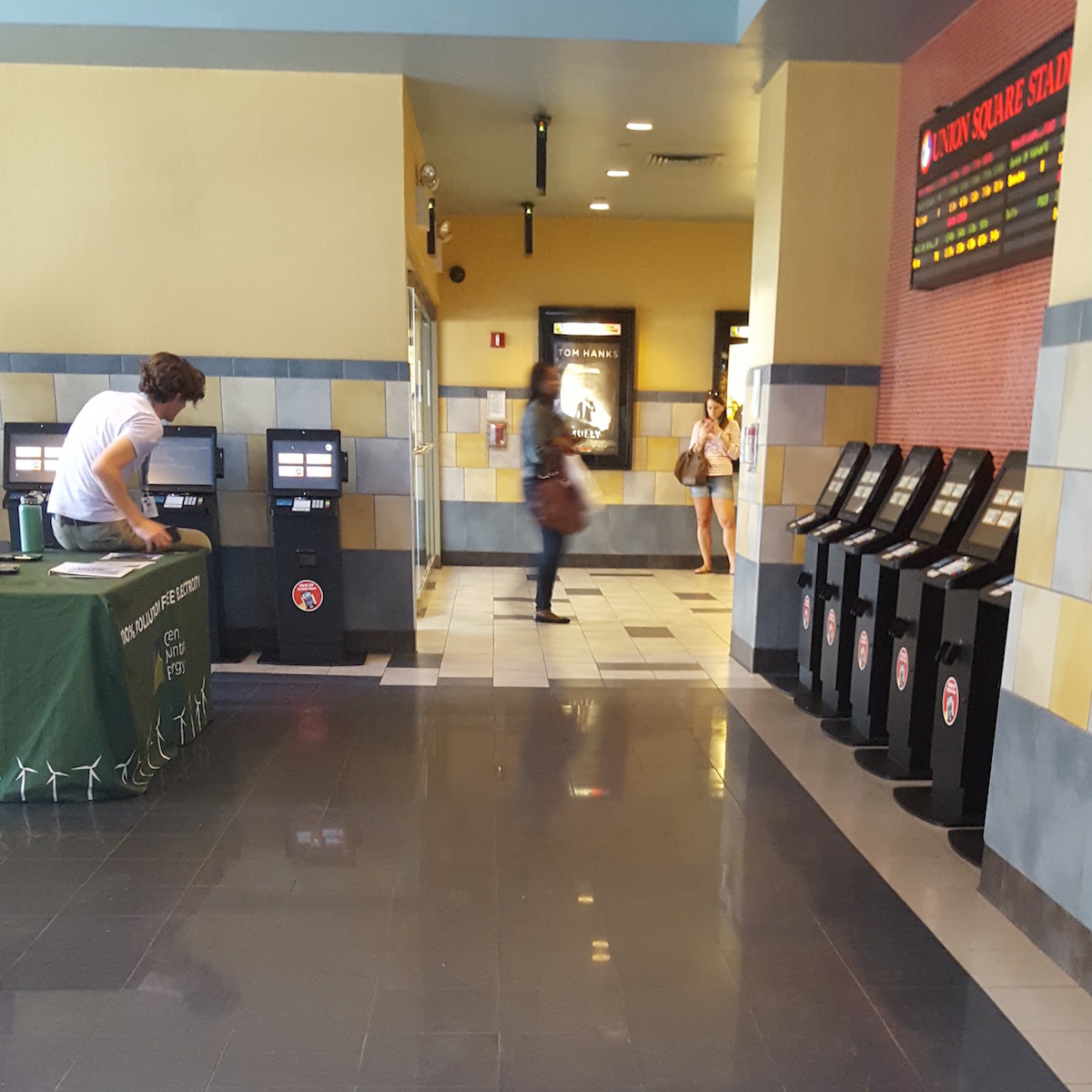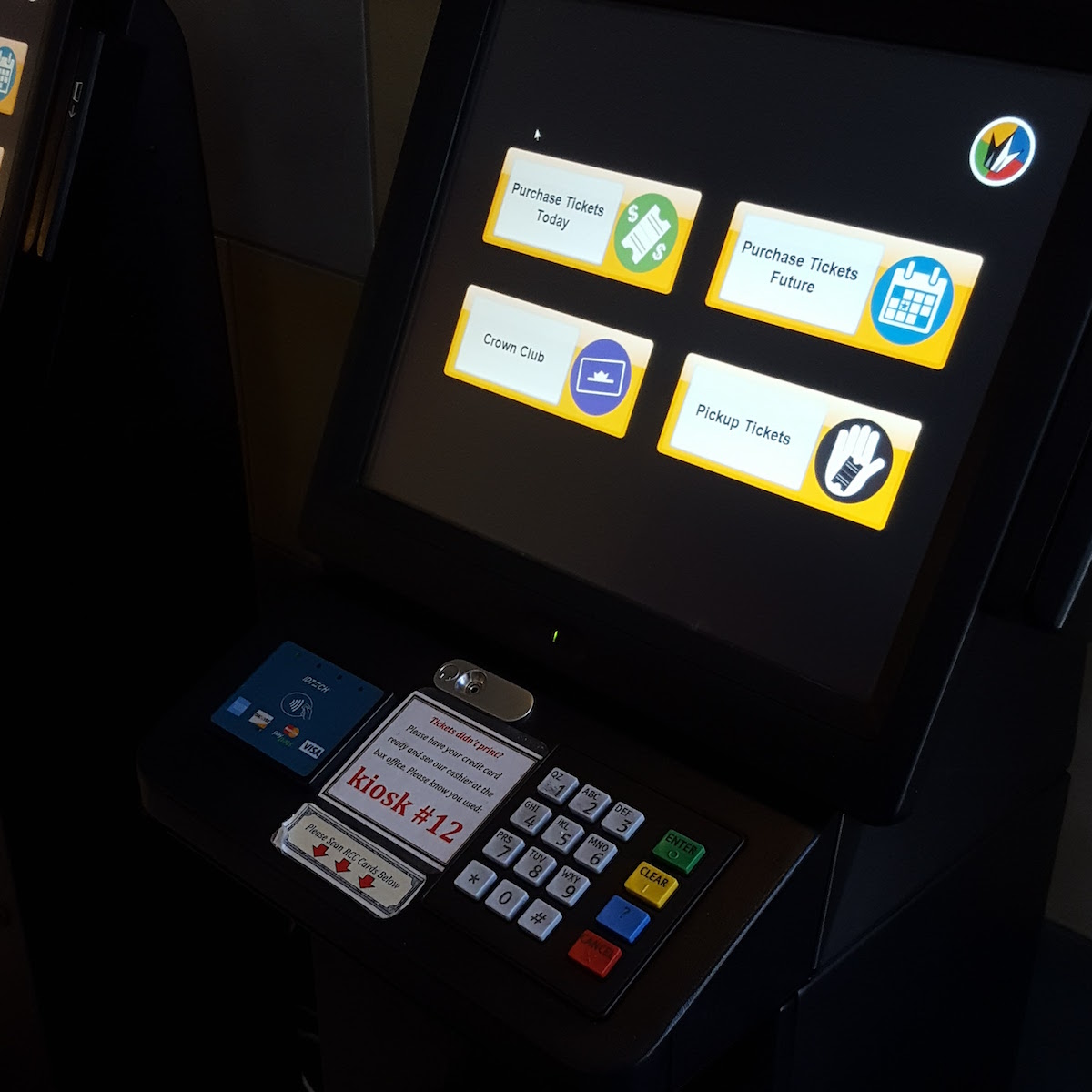Observation
I had a bit of trouble deciding on what piece of interactive technology to observe for this blog post. We had to pick one used by the public, but try not to be seen observing them. Pick one that you can wait around near without being conspicuous. Pick one that you could hopefully take pictures of without seeming like you’re casing the store or establishment. This last criterion was the hardest. It ruled out most stores’ checkout machines, Amazon lockers, and other kiosks.
I also didn’t want to choose any interactive art piece, since there isn’t necessarily a “correct” or expected way to use one of those. After realizing that most NYPL branches are closed on Sundays– my first choice were self-checkout machines for books– I pretended to wait for a friend at the Regal Cinemas Union Square. You could wait a while around the lobby in theatres for a while– waiting for a friend who will never arrive.
I’ve never been to a movie theatre in the US, but I’ve been to a great deal of them in Canada. I assumed that movie habits were largely the same between our two countries. In Canada, most people pick a movie they want to see, arrive around 30-10 minutes before the film, and then buy tickets at a self-serve kiosk. People weren’t entirely behaving as I expected.
Caveats: I was at a Regal theatre, which isn’t the dominant theatre chain in New York as far as I can tell. This was a Sunday afternoon, so there were fewer people than on a Friday evening and had different demographics than the popular nights. There were fewer young people at the theatre, and more middle-aged couples. There were also two guys sitting at a table near the self-checkout machines trying to survey people about Con Edison– a deterrent to using the machines if I’ve ever seen one.

Still, despite these factors, I still believe that theatre goers in Canada would behave differently. First of all, although both American and Canadian chains let you buy tickets in advance, many more Canadians use the feature to print the ticket at the theatre– so much so that Canadian theatres have standalone pickup-only kiosks. Nobody here, as far as I could tell, printed tickets to pickup. If they bought in advance, I assume they printed it out or had them on their phones, as they went straight up the escalators. Additionally, Canadians are much more likely to use the self-service machines entirely– many people (perhaps around 50-60%) from my observations forgo the machines to use the box office. Canadians would use self-service sometimes even if there was no line. Finally, a few of the people I observed engaged in behaviour i rarely saw in Canada– they went to the theatre without having a movie in mind. Before approaching the machine, they stared at the ticker of screenings overhead, and discussed what movie they might want to see. This behaviour seems to be less and less common over the years.
Everyone who used the machines seemed experienced with using them. There was no particular demographic that indicated whether one would use the machine or not– young and old, female and male, and couples and singles both used the box office and ticketing machines in equal quantities.
The machines in its usage were entirely similar to Canadian ticketing kiosks, on the other hand. The starting screen gives you four options: purchase a ticket for today, purchase one for the future, access your rewards account, and pickup tickets that were purchased in advance. Everyone who I observed over 20 minutes picked the first option, which then took them to a screen to select a movie, and then a time, and then the number of tickets. You would then optionally select concessions to purchase (which nobody opted for, similar to Canadians. Nobody wants to buy food without seeing it in front of them, particularly since it’s not discounted for buying here.) and finally, pay for their tickets. Overall, each of these transactions took 30 seconds to one minute.

Honestly, besides the aforementioned differences from Canada (box office vs ticketing machine, picking a movie in advance vs picking it at the theatre, picking up tickets vs printing them out at home) most people did not deviate from the process detailed above. During this process, payment seemed to take the longest– this makes sense, as the machines only take credit and debit cards and therefore require a connection to outside banking services. Beyond this, from the user standpoint, what took the longest was sometimes finding the button in the initial screen– users would be aided if the option to buy tickets today was more prominent, as it is unlikely that a user would pick a different option.
The easiest parts seem to be locating their movie and skipping concession movies. The former is easy because it’s visual and sorted– you’re likely to recognize the movie poster, and you can figure out where it fits in alphabetical order. The latter is easy because the skip purchase button is located in the same place as the button to confirm your number of tickets in the previous screen.
The use of these machines seem to be easy, though, only because the process is simple and the users seem to have used them before. They don’t do particularly well when judged by Crawford’s definition of interactivity, as they don’t give very much feedback for your actions and don’t seem to “think” about your choices. If you select something incorrectly, you don’t get confirmation until the end. The self-serve kiosks were also set apart from the box office line (most of the time in Canada, the kiosks are in the same space as the box office line) so they don’t do well by Norman’s principles of signifiers–people would go into the box office line because cultural signifiers indicate that the line is the way to purchase a ticket, and not the isolated area adjacent to it (with the kiosks.) The icons of the main screen are also fairly nonsensical, and I wouldn’t be able to distinguish purchasing a ticket and picking one up without the labels.
Addendum 1
When I was at the movie theatre, a dude taught me how to sneak into the movie theatre by bypassing some technology. You get someone who paid for a ticket to call the elevator from upstairs, and sneak into the elevator as it’s going up. He was also hitting on me– and everyone knows that a man who refuses to pay for a movie ticket is very alluring.
Addendum 2
I also read the introduction and first chapter of Disability and Design. This was fascinating, and gave me a lot to think about. It reminded me of a few pieces of design for disability that I’ve seen recently: for instance, the Metal Gear Solid prosthetic that a UK man received earlier in the year. It’s always seemed absurd to me how much design for disability is meant to conceal and blend in, especially when contrasted with the futures we imagine in science fiction in which robots and cyborgs are celebrated and artistic. I imagine a future with 3D printing more readily available to the public in which people could print bespoke versions of the prosthetics they want. Everybody is different, and we shouldn’t assume they all want to hide their disability– but if you do, you should be able to have that option as well.
Subscribe via RSS
